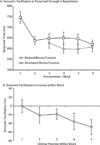Lexical Retrieval is not by Competition: Evidence from the Blocked Naming Paradigm
- PMID: 25284954
- PMCID: PMC4179210
- DOI: 10.1016/j.jml.2014.05.003
Lexical Retrieval is not by Competition: Evidence from the Blocked Naming Paradigm
Abstract
A central issue in research on speech production is whether or not the retrieval of words from the mental lexicon is a competitive process. An important experimental paradigm to study the dynamics of lexical retrieval is the blocked naming paradigm, in which participants name pictures of objects that are grouped by semantic category ('homogenous' or 'related' blocks) or not grouped by semantic category ('heterogeneous' or 'unrelated' blocks). Typically, pictures are repeated multiple times (or cycles) within both related and unrelated blocks. It is known that participants are slower in related than in unrelated blocks when the data are collapsed over all within-block repetitions. This semantic interference effect, as observed in the blocked naming task, is the strongest empirical evidence for the hypothesis of lexical selection by competition. Here we show, contrary to the accepted view, that the default polarity of semantic context effects in the blocked naming paradigm is facilitation, rather than interference. In a series of experiments we find that interference arises only when items repeat within a block, and only because of that repetition: What looks to be 'semantic interference' in the blocked naming paradigm is actually less repetition priming in related compared to unrelated blocks. These data undermine the theory of lexical selection by competition and indicate a model in which the most highly activated word is retrieved, regardless of the activation levels of nontarget words. We conclude that the theory of lexical selection by competition, and by extension the important psycholinguistic models based on that assumption, are no longer viable, and frame a new way to approach the question of how words are retrieved in spoken language production.
Keywords: blocked naming; cyclic naming; lexical retrieval; semantic facilitation; semantic interference; speech production.
Figures







Similar articles
-
Factors determining semantic facilitation and interference in the cyclic naming paradigm.Front Psychol. 2012 Feb 21;3:38. doi: 10.3389/fpsyg.2012.00038. eCollection 2012. Front Psychol. 2012. PMID: 22363309 Free PMC article.
-
The Role of Task-Specific Response Strategies in Blocked-Cyclic Naming.Front Psychol. 2017 Jan 4;7:1955. doi: 10.3389/fpsyg.2016.01955. eCollection 2016. Front Psychol. 2017. PMID: 28119637 Free PMC article. Review.
-
What can Written-Words Tell us About Lexical Retrieval in Speech Production?Front Psychol. 2016 Jan 6;6:1982. doi: 10.3389/fpsyg.2015.01982. eCollection 2015. Front Psychol. 2016. PMID: 26779090 Free PMC article.
-
Strategic origins of early semantic facilitation in the blocked-cyclic naming paradigm.J Exp Psychol Learn Mem Cogn. 2017 Oct;43(10):1659-1668. doi: 10.1037/xlm0000399. Epub 2017 Apr 6. J Exp Psychol Learn Mem Cogn. 2017. PMID: 28383951
-
Cumulative and non-cumulative semantic interference in object naming: evidence from blocked and continuous manipulations of semantic context.Q J Exp Psychol (Hove). 2013;66(11):2135-60. doi: 10.1080/17470218.2013.775318. Epub 2013 Mar 22. Q J Exp Psychol (Hove). 2013. PMID: 23521507 Review.
Cited by
-
Single-word predictions of upcoming language during comprehension: Evidence from the cumulative semantic interference task.Cogn Psychol. 2015 Jun;79:68-101. doi: 10.1016/j.cogpsych.2015.04.001. Epub 2015 May 1. Cogn Psychol. 2015. PMID: 25917550 Free PMC article.
-
Does segmental overlap help or hurt? Evidence from blocked cyclic naming in spoken and written production.Psychon Bull Rev. 2016 Apr;23(2):500-6. doi: 10.3758/s13423-015-0900-x. Psychon Bull Rev. 2016. PMID: 26179140 Free PMC article.
-
Predictive language processing: integrating comprehension and production, and what atypical populations can tell us.Front Psychol. 2024 May 21;15:1369177. doi: 10.3389/fpsyg.2024.1369177. eCollection 2024. Front Psychol. 2024. PMID: 38836235 Free PMC article. Review.
-
Incremental learning of perceptual and conceptual representations and the puzzle of neural repetition suppression.Psychon Bull Rev. 2016 Aug;23(4):1055-71. doi: 10.3758/s13423-015-0855-y. Psychon Bull Rev. 2016. PMID: 27294423 Review.
-
The Role of the Dorsolateral Prefrontal Cortex in the Production and Comprehension of Phonologically and Semantically Related Words.Brain Sci. 2023 Jul 22;13(7):1113. doi: 10.3390/brainsci13071113. Brain Sci. 2023. PMID: 37509043 Free PMC article.
References
-
- Abdel Rahman R, Melinger A. When bees hamper the production of honey: Lexical interference from associates in speech production. Journal of Experimental Psychology: Learning, Memory and Cognition. 2007;33:604–614. - PubMed
-
- Abdel Rahman R, Melinger A. Semantic context effects in language production: A swinging lexical network proposal and a review. Language and Cognitive Processes. 2009a;24:713–734.
-
- Abdel Rahman R, Melinger A. Dismissing lexical competition does not make speaking any easier: A rejoinder to Mahon and Caramazza (2009) Language and Cognitive Processes. 2009b;24:749–760.
-
- Abdel Rahman R, Melinger A. The dynamic microstructure of speech production: Semantic interference built on the fly. Journal of Experimental Psychology: Learning, Memory, and Cognition. 2011;37:149–161. - PubMed
-
- Alario F-X, Moscoso del Prado Martin F. On the origin of the cumulative semantic inhibition effect. Memory & Cognition. 2010;38:57–66. - PubMed
Grants and funding
LinkOut - more resources
Full Text Sources
Other Literature Sources
